How Students in Salt Lake City Helped Advance an Equity Centered Plan for Electric School Buses
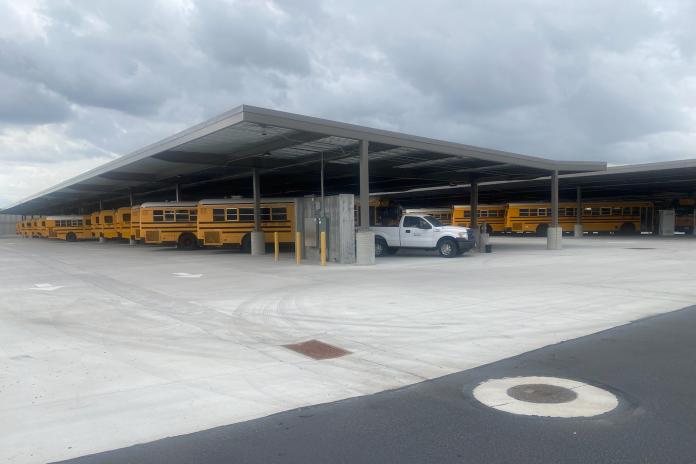
In collaboration with partners and communities, WRI’s Electric School Bus Initiative aims to build unstoppable momentum toward an equitable transition of the U.S. school bus fleet to electric, bringing health, climate and economic benefits to children and families across the country and normalizing electric mobility for an entire generation. The Electric School Bus Series shows how superintendents and fleet managers across the United States have pursued school bus electrification in their own communities. This edition covers Salt Lake City School District in Utah, who is pairing electric school buses with on-site solar to meet a student-driven sustainability resolution aiming for carbon neutrality for the school district by 2040.
This piece is based off an interview with Ken Martinez, Transportation Director for Salt Lake City School District.
In 2019, students from Salt Lake City School District (SLCSD) in Utah banded together with local advocates like the Sierra Club and brought forward a sustainability resolution to their Board of Education. As a result of this student-led initiative, SLCSD is embarking on a path to 100% renewable energy use by 2030 and full carbon neutrality by 2040. One of the six strategies outlined in the district’s Sustainability Action Plan is to electrify school buses, the light-duty fleet and offroad vehicles by 2040. As a first step, eight of the district’s 100 buses are currently electric – the first in the state – and four more are on the way.
Motivation & Co-benefits
The students’ campaign, which was part of the 100% Clean Energy Schools Campaign focused primarily on the detrimental effects of climate change through increased temperatures, poor air quality (exacerbated during the city’s winter inversion season — a local weather phenomenon), changes in water systems, increased wildfires, extreme weather events and other environmental disruptions. With unanimous Board approval in June 2020, the district ramped up sustainability and clean energy efforts; created a task force made up of students, faculty, staff and community partners; and published a Sustainability Action Plan. In describing the Plan, Superintendent Timothy Gadson said “equity-centered climate action and sustainability are crucial cornerstones to our undertaking.”
As a core element of the plan, the district has paired zero-tailpipe emitting electric school buses with solar canopies at their depot. The solar canopies serve a double purpose: generating clean energy on-site while creating safer conditions at the depot for drivers who often slipped and fell in winter conditions.
Transportation Director Ken Martinez is an important champion for the effort. “We want to be as green as we can [be] by 2030,” he said. In a previous role, Martinez worked at a district operating school buses fueled by compressed natural gas (CNG). In his experience, CNG proved challenging in winter months when the fuel would freeze due to a drop in pressure. Furthermore, diesel buses struggled to burn efficiently due to SLCSD's stop-and-go urban routes. With these factors in mind, Martinez viewed electric as a perfect fit.
Partners & Advocates
The district’s electric school bus journey began in 2017, prior to the sustainability resolution and plan, when Martinez partnered with Utah’s Division of Air Quality within the Department of Environmental Quality (DEQ). The agency was looking to bring electric school buses to the state to reduce the pollution impact during the winter inversions, particularly with an eye towards buses that would operate in Salt Lake City’s Rose Park neighborhood. Rose Park is a community located on the west side of the city that is disproportionately impacted by air quality and environmental justice (EJ) issues like hazardous waste sites that will be the subject of a new EJ study by the US EPA. As such, the Division of Air Quality provided 65% of the funding for the first four buses and accompanying chargers through state Volkswagen Settlement funding and 45% of the funding for the second batch of four buses and chargers through its Clean Diesel grant program, amounting to $2.3 million in grant funding.
Implementation Status
SLCSD operates eight electric Micro Bird and Blue Bird school buses. First, the district tested four Type A Micro Birds ($233,431 each), as they were the most affordable offering at the time when they received the buses in April 2021. The Type A buses transport students with disabilities. While mileage is lower for these routes (around 47 miles per day), these buses have high idle times and thus see a major reduction in NOx emissions compared to diesel. In addition to reduction in exposure to air pollutants, Martinez and his team have noticed that some students with disabilities are calmer due to the quieter and smoother experience on the electric buses, dubbing them “an extension of the classroom.”
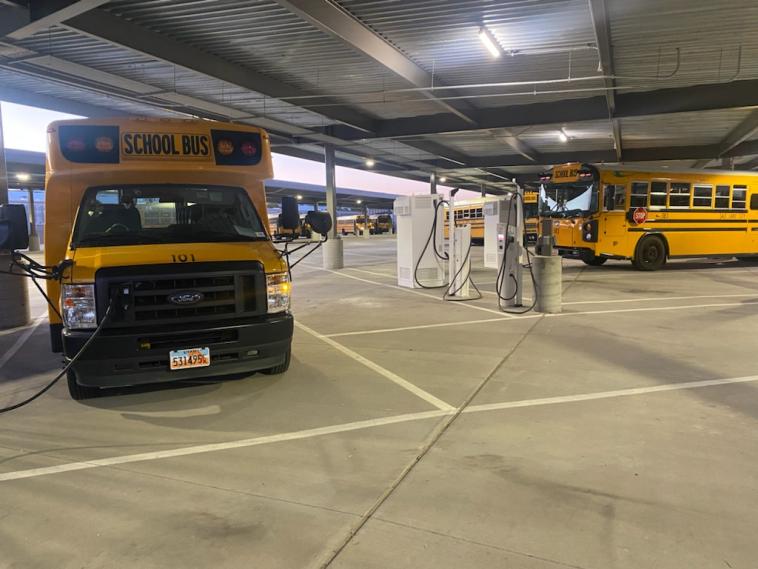
After receiving additional funding, SLCSD ordered four Type D All Americans ($361,813 each). For these buses, the district prioritized assigning the buses to the longest routes (92 miles per day) and those that drive through western Salt Lake City, where students and communities disproportionately experience higher levels of air pollution. Even on the coldest days, when temperatures fall below 30 degrees F and electric heater use draws around 18% of range, the buses can cover the longest routes by utilizing midday charging and regenerative braking. Regenerative breaking is a practice in which kinetic energy is converted into usable energy to extend the range of the bus – a ~16-17% in-route battery gain when driving down a mountain pass at 55-57 miles per hour, in the experience of SLCSD. The team has even deployed the electric buses on field trips to ski mountains and local canyons, finding the buses are able to cover their most challenging routes, and have even used public charging at a motel when on their way to a convention. In exploring the limits of their buses and, in one instance, needing a tow, Martinez has implemented a rule that if a driver is nearing 20% remaining battery charge and they are not within the last stop or heading back to the depot, they must return or call for a spare bus.
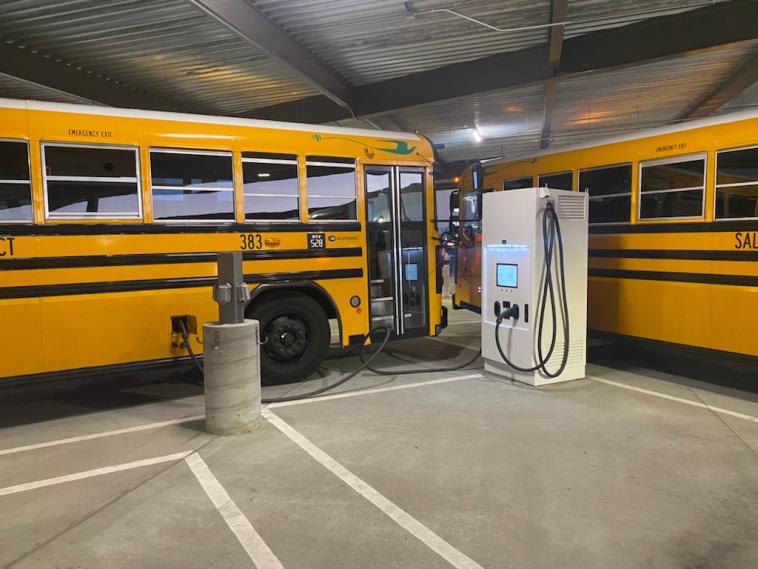
Martinez selects drivers for electric routes based on seniority and experience so that they may apply their knowledge and past experiences to testing this new fuel type. For the team, test driving in a range of conditions has been important. While the first runs struggled with 60 miles, the drivers soon mastered new elements of the electric bus along with regenerative braking practices, which bumped the range up to over 90 miles per charge.
The district is taking a holistic approach to clean energy assets by pairing its electric school buses with solar power from the canopies. Today, nearly half of the transportation department’s facility’s energy needs are covered by 500 solar panels generating 200 kilowatts (kW). The second phase of solar implementation will result in an additional 200 kW, covering 96% of energy needs. Ultimately, the third phase will result in full coverage of the facility and some portion to power the bus chargers. The district is open to exploring microgrids and other resiliency strategies down the line.
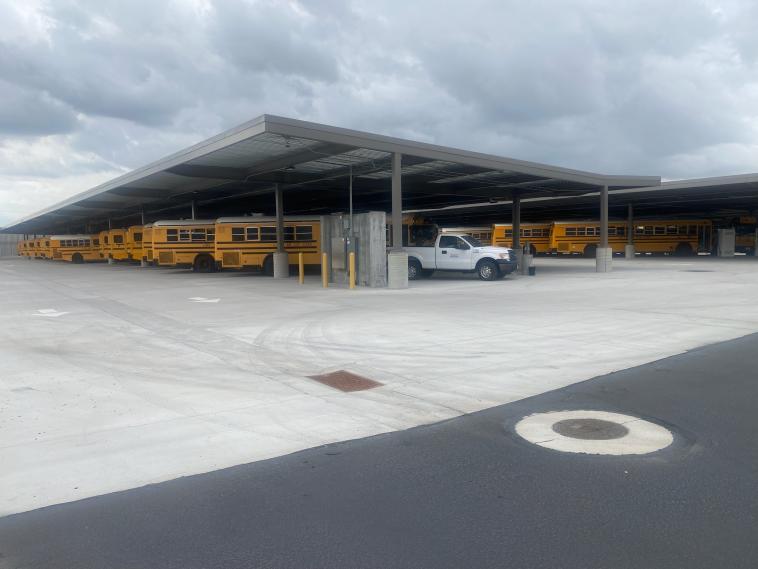
Looking ahead, SLCSD is expecting four more electric school buses in December 2022 and applied for 12 electric buses (11 of which would be wheelchair-equipped) through the federal Clean School Bus Program (they are currently on the wait list for this first round of awards). With this pace in mind, the Transportation Department recently removed its underground diesel storage tank in exchange for a smaller above ground source. They are also working closely with their electric utility, Rocky Mountain Power, to evaluate current and future electric school bus energy needs and how best to manage grid impact. When the bus batteries reach the end of their useful life for transportation, Martinez sees secondary life potential for stationary storage for their on-site solar. The batteries are expected to retain around 70% of initial capacity, which is why Martinez chose to purchase rather than lease the batteries. He is also interested in exploring vehicle-to-grid (V2G) capabilities – in which the buses would store energy and discharge it to the grid at strategic times – and how buses can be used for field trips, as there has been private industry interest in developing a charging corridor in the Wasatch Front.
On the whole, students are energized about the progress to date. “It has been so exciting to watch the progress SLCSD has made since the passing of the 100% Clean Energy Resolution in 2020, especially knowing how youth are particularly vulnerable to fossil fuel pollution,” said Lola Maldonado, a graduate of Highland High School who was one of the nine students who helped develop SLCSD’s Sustainability Resolution. “Since our resolution passed we have been able to establish and begin executing ambitious energy and social goals related to sustainability. These immediate results began with the implementation of electric school buses in frontline school communities, which truly shows how impactful sustainability resolutions can be.”
Greatest Challenges
The greatest learning curve has been the charging infrastructure. The facility is equipped with four Level 2 16.8 kW charging stations and two 100 kW DC fast charging stations with two charging ports per pedestal, all BTC Power brand chargers. Underground electrical infrastructure is in place for one additional 100 kW dual fast charge station to serve the next four buses.
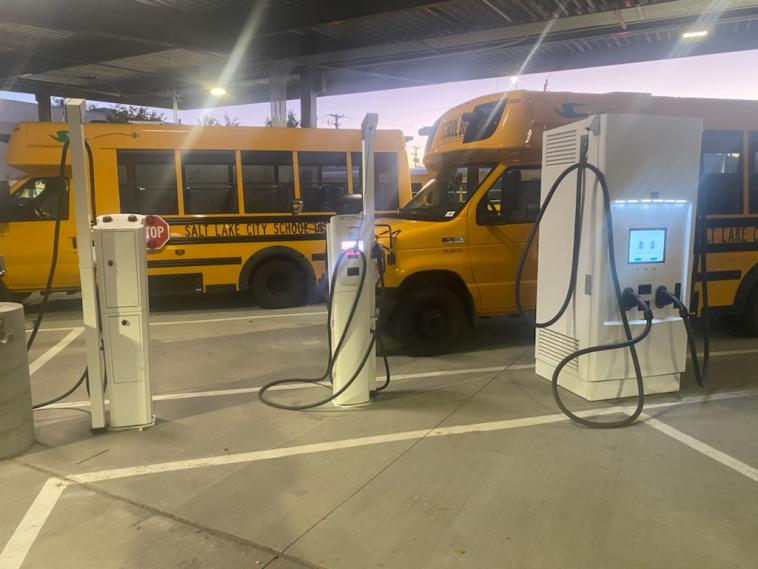
SLCSD has not experienced any issues with the Level 2 chargers. With the DC fast chargers, however, there have been challenges with compatibility and identifying the appropriate party to resolve issues. The Blue Bird buses, powered by Cummins drive trains, cannot accept more than 60 kW of power, meaning the 100 kW chargers have a surplus of power output. This mismatch interrupted communication between the bus and the charger, and reaching a resolution took around two months. This lag was due, in part, to difficulties identifying which party would resolve the issue: SLCSD typically purchases through their state contract, but because no charger was listed that would meet their needs, they went through a third-party vendor. This arrangement included the charger but not a service agreement or coverage for the communication link between bus and charger.
Having navigated these dynamics, Martinez advises school districts to work with their bus manufacturers to identify chargers that will work with their bus, buy direct or make sure a third-party vendor will cover all servicing needs that arise. SLCSD is now exploring alternative DC fast chargers for midday charging and will rely more upon Level 2 charging to reduce these complex dynamics.
Advice for Other School Districts
Martinez emphasized the value of peer learning opportunities, advising school districts to reach out to those in similar operating conditions or in their region. Given SLCSD is the first and only electric school bus operator in the state, Martinez has visited school districts in southern California to learn about their experiences. Additionally, he hopes to reconnect later on with the students who worked to make this school district more sustainable, “so they can see that they have a voice [and] that it does matter because [their voice] can be a powerful learning tool, not only for the students but for the administration as well.”
Advocates like Utah’s Sierra Club Chapter are compelled by student leadership statewide and encourage school districts to listen to student voices. Bekah Ashley, Organizing Representative for the Sierra Club Utah Chapter, said “We are inspired by the student leadership — not just in Salt Lake but in neighboring school districts like Park City, Granite and Davis, where young people are leading similar campaigns to address the impacts of climate change and work toward climate justice in both schools and the broader community.”
Maldonado echoed this sentiment: “I am encouraged by the growing number of schools participating in student-led sustainability initiatives and hope that SLCSD's resolution helps young people recognize their power within the climate movement.”
Additional Resources
- Salt Lake City School District Sustainability Home Page
- Salt Lake City School District Sustainability Resolution (student-led; unanimously approved by Board June 2020)
- Salt Lake City School District Sustainability Action Plan (September 2021)
- Utah Department of Environmental Quality (DEQ) Funding: Volkswagen Settlement and Clean Diesel Program
- Environmental Protection Agency Clean School Bus Program: Two Utah Recipients (Tintic and Uintah) and ten Waitlisted school districts/schools
Want to learn more from the Electric School Bus Series? Explore more stories here.